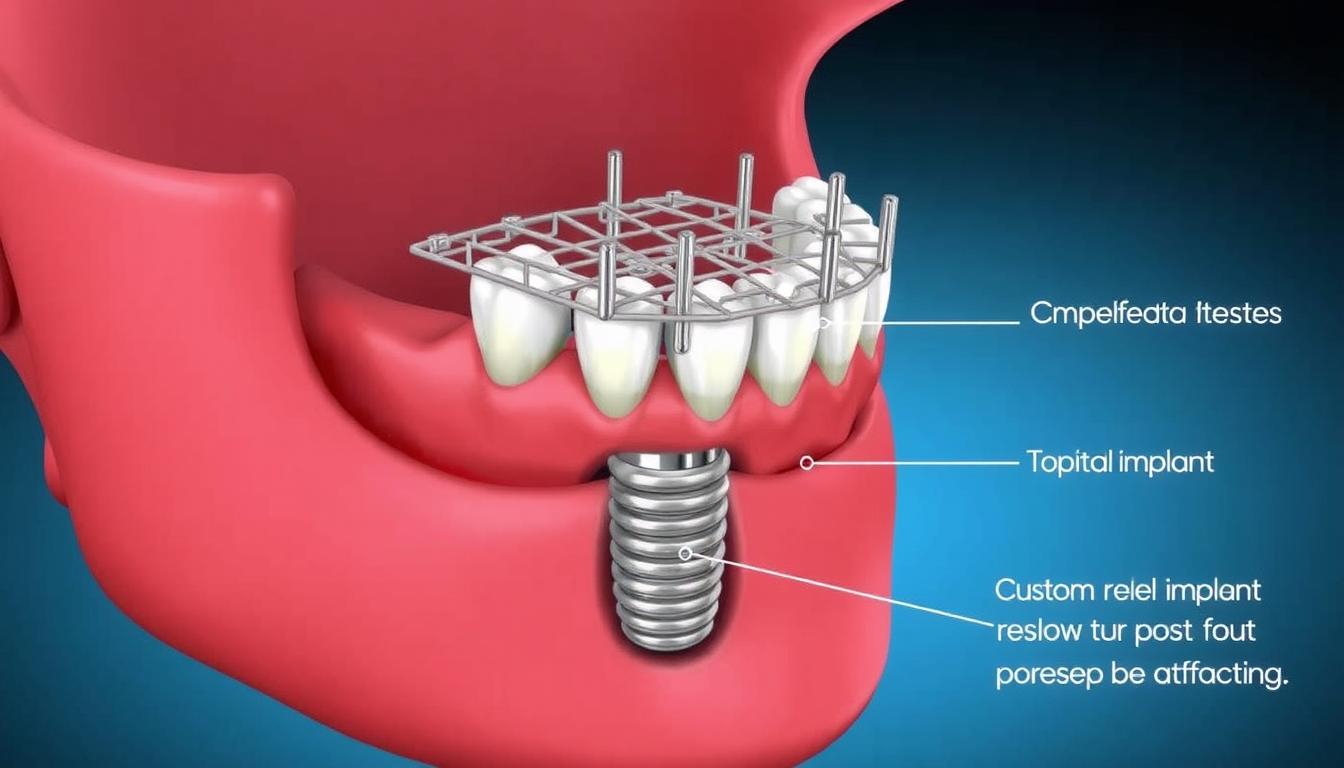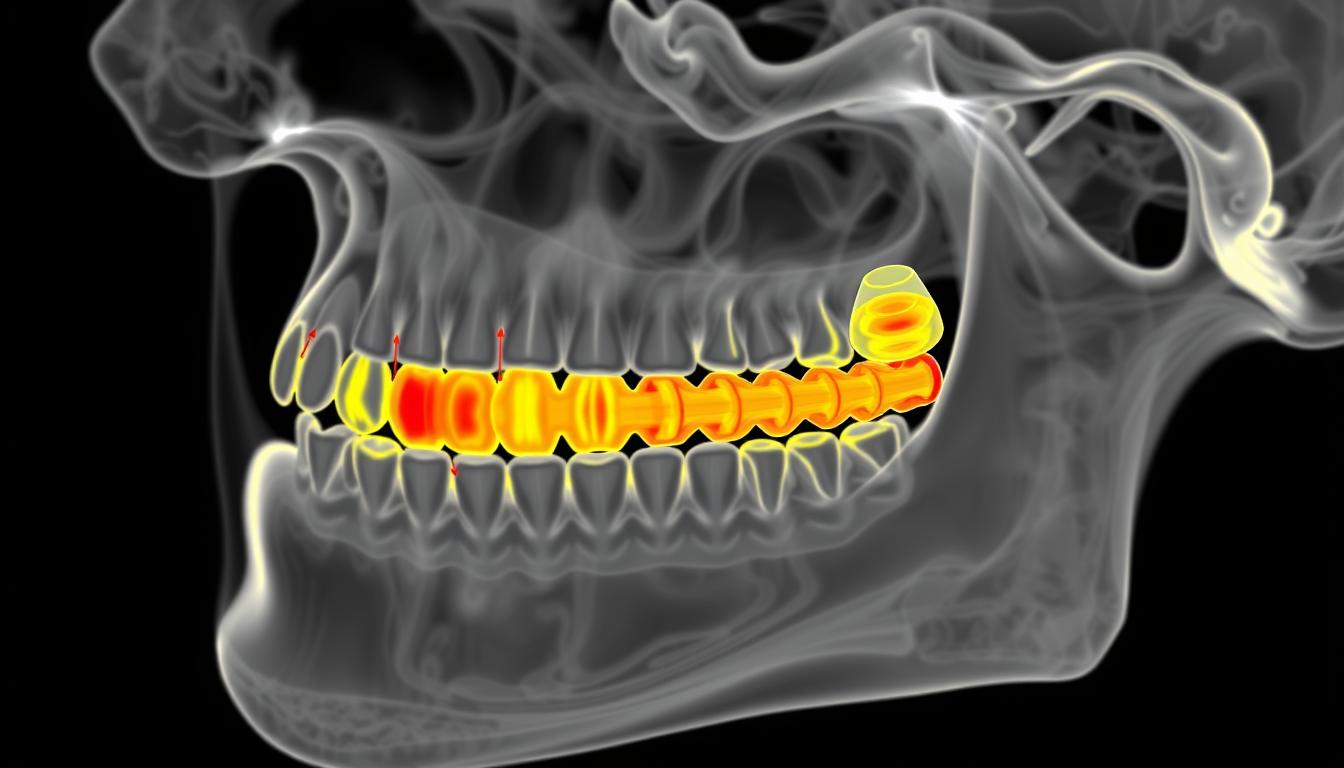What Are Subperiosteal Implants?

Subperiosteal implant structure showing the metal framework positioned on the jawbone
Subperiosteal implants are a specialized type of dental implant designed for patients with insufficient jawbone density. Unlike traditional endosteal implants that are inserted directly into the jawbone, a subperiosteal implant consists of a custom-made metal framework that sits on top of the bone but underneath the gum tissue.
The framework features small posts that protrude through the gum line, providing attachment points for artificial teeth. This design makes subperiosteal implants an excellent option for patients who cannot undergo bone grafting procedures or who have experienced significant bone resorption due to long-term tooth loss.
The term “subperiosteal” refers to the placement location – “sub” meaning under, and “periosteal” referring to the periosteum, which is the membrane covering the outer surface of bones. This placement allows the implant to gain stability from the existing bone structure without requiring the depth needed for traditional implants.
Comparing Subperiosteal Implants to Other Options
Subperiosteal Implants
- Placed on top of the jawbone, under the gum
- Custom-designed metal framework
- No bone grafting required
- Ideal for severe bone loss cases
- Less common in modern dentistry
- More complex surgical procedure
Endosteal Implants
- Placed directly into the jawbone
- Screw or cylinder-shaped titanium posts
- May require bone grafting
- Most common implant type
- Widely available treatment option
- Requires adequate bone density
Zygomatic Implants
- Anchored in the cheekbone (zygoma)
- Extra-long titanium posts
- No bone grafting required
- For severe upper jaw bone loss
- Specialized procedure
- Requires highly skilled surgeon
While endosteal implants remain the most common choice for tooth replacement, subperiosteal implants offer unique advantages for specific patient situations. Their placement on top of the jawbone makes them suitable for patients who cannot receive traditional implants due to bone loss and are unwilling or unable to undergo bone grafting procedures.
Zygomatic implants, another alternative for patients with bone loss, are specifically designed for the upper jaw and anchor into the cheekbone. In contrast, subperiosteal implants can be used in both the upper and lower jaw, providing more versatility for certain patients.
The Subperiosteal Implant Procedure

The subperiosteal implant procedure typically involves multiple steps and requires specialized expertise. Understanding the process can help you prepare for what to expect if you’re considering this treatment option.
Initial Consultation and Imaging
The process begins with a comprehensive examination and advanced imaging. Your dentist will take detailed CT scans or 3D images of your jaw to assess bone structure and create a precise model for your custom implant framework.

3D imaging is essential for creating a precise custom framework
Custom Framework Design
Using the 3D model of your jaw, a dental laboratory will create a custom metal framework designed to fit perfectly over your existing bone structure. This framework is typically made from biocompatible materials like titanium that integrate well with human tissue.
Surgical Placement
The surgical procedure for placing a subperiosteal implant can follow either a one-stage or two-stage approach:
Two-Stage Procedure (Traditional)
- First surgery: The dentist makes an incision in the gum to expose the jawbone
- An impression of the exposed bone is taken
- The gum is sutured closed while the custom framework is fabricated
- Second surgery (2-3 weeks later): The gum is reopened
- The custom framework is placed on the jawbone
- The gum tissue is sutured around the posts that protrude through the gum
One-Stage Procedure (Modern Approach)
- CT scans and 3D imaging create a precise model of your jawbone
- The custom framework is designed and fabricated before surgery
- A single surgery is performed to place the pre-made framework
- The gum is sutured around the protruding posts
Recovery and Healing
After placement, a healing period of 3-6 months allows the gum tissue to heal around the framework. During this time, you’ll typically wear a temporary denture or bridge. Once healing is complete, your permanent replacement teeth will be attached to the posts that extend from the framework.
Advantages and Disadvantages of Subperiosteal Implants
Advantages
- No bone grafting required, making it suitable for patients with significant bone loss
- Shorter overall treatment time compared to bone grafting followed by traditional implants
- Can support multiple teeth with a single framework
- Provides a fixed solution rather than removable dentures
- Preserves facial structure and prevents further bone loss
- Custom-designed for each patient’s unique jaw anatomy
Disadvantages
- Higher risk of infection compared to endosteal implants
- More complex surgical procedure requiring specialized expertise
- May be more expensive than traditional implants
- Less commonly performed, so fewer dentists offer this option
- Limited long-term data compared to traditional implants
- Potential for framework exposure if gum tissue recedes

Before and after restoration with subperiosteal implants
Are You a Candidate for Subperiosteal Implants?
Subperiosteal implants are specifically designed for patients who cannot receive traditional dental implants. Understanding if you’re an ideal candidate can help you make an informed decision about your treatment options.
Ideal Candidates for Subperiosteal Implants

- Advanced bone resorption – Patients who have experienced significant jawbone loss due to long-term tooth absence
- Unable to undergo bone grafting – Those who cannot have bone augmentation procedures due to health concerns or personal preference
- Failed previous implants – Patients who have had unsuccessful traditional implant procedures
- Anatomical limitations – Those with jawbone structures that make traditional implants challenging
- Good overall health – Patients healthy enough to undergo oral surgery and healing
Health Considerations and Contraindications
While subperiosteal implants offer solutions for many patients, certain conditions may affect candidacy:
- Uncontrolled diabetes – May impair healing and increase infection risk
- Smoking – Significantly reduces success rates and healing capacity
- Autoimmune disorders – May complicate healing and integration
- Radiation therapy to the jaw area – Can compromise bone health and healing
- Severe gum disease – Must be treated before implant placement
Discover If You’re a Candidate
Our specialists can evaluate your specific situation and determine if subperiosteal implants are right for you.
Understanding Subperiosteal Implant Costs

Subperiosteal implants typically cost more than traditional dental implants due to their customized nature and the specialized expertise required. Understanding the factors that influence cost can help you plan for this investment in your oral health.
Cost Factors for Subperiosteal Implants
| Cost Factor | Description | Approximate Range |
| Custom Framework | Design and fabrication of the personalized metal framework | $3,000 – $5,000 |
| Surgical Procedure | One or two surgical sessions for placement | $2,000 – $4,000 |
| Prosthetic Teeth | Artificial teeth attached to the framework | $1,000 – $3,000 per tooth |
| Preliminary Procedures | CT scans, consultations, and other diagnostics | $500 – $1,500 |
| Geographic Location | Costs vary by region and urban/rural setting | Varies widely |
The total cost for a full subperiosteal implant procedure typically ranges from $10,000 to $25,000, depending on the complexity of your case and the number of replacement teeth needed. While this represents a significant investment, many patients find the long-term benefits of a fixed, functional solution outweigh the initial cost.
Insurance and Financing Options
Dental insurance may provide partial coverage for subperiosteal implants, particularly if they’re deemed medically necessary. Many dental practices also offer financing options or payment plans to help make treatment more accessible. Be sure to discuss financial considerations with your dental provider during your consultation.
Caring for Your Subperiosteal Implant
Proper maintenance is essential for the long-term success of your subperiosteal implant. With appropriate care, these implants can provide years of reliable function and aesthetic benefits.
Daily Care Routine
- Brush twice daily with a soft-bristled toothbrush
- Use low-abrasive, antimicrobial toothpaste
- Clean around implant posts with interdental brushes
- Floss daily with implant-specific floss or water flossers
- Rinse with alcohol-free antimicrobial mouthwash
Professional Maintenance
- Schedule dental checkups every 3-4 months initially
- Transition to twice-yearly visits after stability is confirmed
- Professional cleaning with specialized instruments
- Regular assessment of implant stability and gum health

Proper cleaning techniques help ensure long-term implant success
Important: Contact your dentist immediately if you notice any of these warning signs: persistent pain, swelling, bleeding around the implant, loosening of the prosthetic teeth, or visible exposure of the metal framework.
Frequently Asked Questions About Subperiosteal Implants
How long do subperiosteal implants last?
With proper care and maintenance, subperiosteal implants can last 10-15 years or longer. Their longevity depends on several factors, including oral hygiene practices, regular dental checkups, overall health, and lifestyle habits. Patients who maintain excellent oral hygiene and attend regular dental appointments typically experience the best long-term results.
Is the subperiosteal implant procedure painful?
The procedure is performed under local anesthesia, so you shouldn’t feel pain during the surgery itself. Some discomfort, swelling, and bruising are normal after the procedure and typically peak within 48-72 hours. Your dentist will prescribe appropriate pain management medications to keep you comfortable during recovery. Most patients report that the discomfort is manageable and subsides within a week.
Why are subperiosteal implants less common today?
Subperiosteal implants have become less common due to advancements in bone grafting techniques and alternative implant options. Modern bone augmentation procedures now allow many patients with bone loss to receive traditional endosteal implants. Additionally, options like zygomatic implants and All-on-4 implants provide alternatives for severe bone loss cases. However, subperiosteal implants remain a valuable option for specific patients who cannot undergo bone grafting or other implant procedures.

Is a Subperiosteal Implant Right for You?
Subperiosteal implants offer a specialized solution for patients with jawbone loss who cannot receive traditional dental implants. While less common in modern dentistry, they remain a valuable option for specific cases where bone grafting is not feasible or desired.
The decision to pursue subperiosteal implants should be made in consultation with a dental specialist who can evaluate your unique situation. By understanding the procedure, benefits, limitations, and maintenance requirements, you can make an informed choice about whether this treatment option aligns with your oral health needs and goals.
Remember that successful outcomes depend on choosing an experienced provider, following all pre- and post-operative instructions, and maintaining diligent oral hygiene practices. With proper care, subperiosteal implants can provide years of functional and aesthetic benefits, restoring your ability to eat, speak, and smile with confidence.
Ready to Explore Your Dental Implant Options?
Schedule a consultation with our dental implant specialists to determine if subperiosteal implants are the right solution for your unique needs.

245ixd